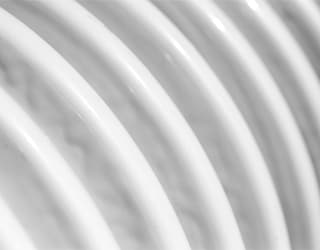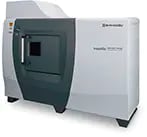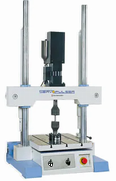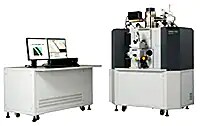Ceramics/Glasses Materials Testing

Testing, Analysis and Inspection of Ceramics and Glass
Shimadzu offers a complete range of instrumentation for the characterization of both traditional and advanced technical ceramic materials. Whether your work involves structural ceramics, whitewares, refractories or advanced materials such as Yttrium barium copper oxide superconductors, Shimadzu provides state-of-the art instrumentation to meet your characterization requirements.
Featured Applications - Glasses
Fracture Observation of Glass in Ring-on-Ring Bending Test

In this experiment, the fracture behavior of strengthened glass in a ring-on-ring bending test was observed using a Shimadzu Hyper Vision HPV-X2 high-speed video camera. The HPV-X2 has a recording speed of maximum 10 million frames per second (10 Mfps), which not only made it possible to clearly observe the point of origin of the fracture, but also the detailed condition of crack propagation.
Measurement for Monotonic Equibiaxial Flexural Strength of Glass

Mobile products require the strength to resist bends, drops and other external forces, and any glass pieces must also be sufficiently strong. For glass, there are typically two types of strength, which are measured by different methods. One type is edge strength, which is obtained from 3-point (or 4-point) bending tests. The other type is surface strength, which is determined from ring bending tests. In this method, fracture starts near the center of the glass, so there is no cut surface impact. In other words, surface strength could be called an indicator of the strength of the glass surface itself. In this article, we introduce an example of a ring bending test, as per the ASTM standard, to obtain the surface strength of glass.
Observation of Camera Lens Assembly Status (X-ray CT)

When CT images of digital camera lenses are obtained, the CT images often include lens artifacts that make it difficult to observe the assembly status. However, this problem can be solved by modifying the orientation of the lens being scanned by the CT system. This example describes the use of a Shimadzu microfocus X-ray CT system to observe a digital camera lens.
Measurement of Antireflective Coating on Eyeglass Lenses (UV)

Specular reflectance measurements are used for an extremely wide range of applications, such as evaluating the performance of materials with low reflectance like antireflective coatings used on lenses and LCDs or evaluating the performance of materials with high reflectance like laser mirrors. Specular reflectance is measured using an absolute reflectance attachment or specular reflectance attachment. In this example, an eyeglass lens with an antireflective coating was measured using a specular reflectance attachment and an absolute reflectance attachment.
Qualitative-Quantitative Analysis of Glass (EDX)

Since Energy Dispersive X-ray (EDX) fluorescence spectrometers can analyze unmodified samples, regardless of their size, they can easily analyze glass bottles or pieces thereof, laserdisc masters, or other massive items. In this example, borosilicate glass is analyzed by qualitative-quantitative analysis.
Measurement of Solar Transmittance through Plate Glass

Various types of functionally enhanced glass with heat-blocking properties have been used in windows to inhibit the transmission of infrared light, as one way to combat global warming, the heat island effect, and other problems. JIS regulates solar transmittance as an index of the transmission characteristics of sunlight, which includes visible to near-infrared light. In this example, several types of glass were measured using a UV-3600 UV-VIS-NIR spectrophotometer and their solar transmittance was calculated using solar transmittance software.
Fatigue Testing of Glass Fiber Reinforced Plastics (GFRP)

Glass fiber-reinforced plastics (GFRP) are ultra-strong composite materials with excellent thermal and electrical insulation properties. They have been rapidly adopted in automobiles, OA equipment, and consumer electronics. The automobile field demands the development of GFRP materials with superior functionality (properties), with emphasis on shock resistance and fatigue strength.
Featured Applications - Ceramics
Analysis of Platinum in Ceramics Using EPMA

Some well-known ceramics are oxides that support a noble metal. While noble metals themselves, particularly platinum (Pt), have low reactivity, they have the property of causing other substances to interact with each other. Due to the low reserves of platinum in the world, measures are being taken to reduce its consumption. This makes it extremely important to produce finer platinum particles and establish an efficient dispersion method for the development of catalysts.



